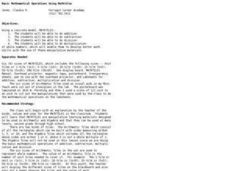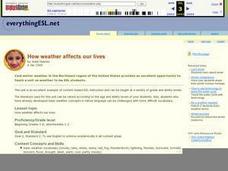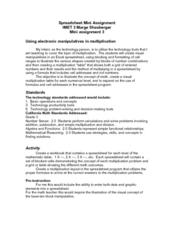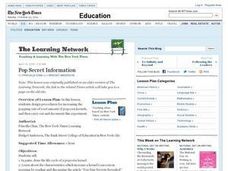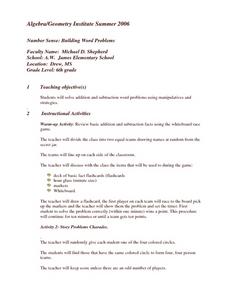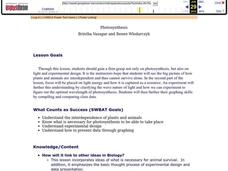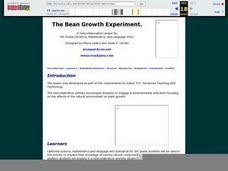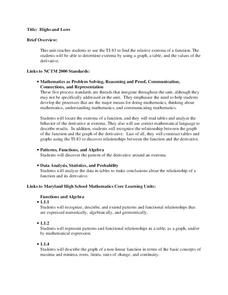EngageNY
Adding and Subtracting Rational Expressions
There's a fine line between a numerator and a denominator! Learners find common denominators in order to add and subtract rational expressions. Examples include addition, subtraction, and complex fractions.
Curated OER
Basic Mathematical Operations Using Math Tiles
Practice addition, subtraction, multiplication, and division using tiles as manipulatives. In this math operations lesson, young learners choose the appropriate sized tiles, arrange them according to directions given by the teacher, and...
EngageNY
Equivalent Rational Expressions
Rational expressions are just fancy fractions! Pupils apply fractions concepts to rational expressions. They find equivalent expressions by simplifying rational expressions using factoring. They include limits to the domain of the...
Curated OER
How Weather Affects Our Lives
English learners practice basic weather terms from listening to two books. They keep a daily weather record for two weeks to record the type of weather, as well as the high and low temperatures for each day. Next, they complete a simple...
Curated OER
Using Electronic Manipulatives in Multiplication
Factor polynomials using electronic manipulatives. Your class will create a spreadsheet in excel and use it to multiply and perform basic operations and solve problems correctly. They create a visual to go along with each multiplication...
Curated OER
Teaching Arithmetic and Math Concepts to Headstarters
Students discover early number concepts for numbers 1 through 5. In this number concepts lesson, students work in stations doing hands-on activities such as sorting colored blocks, stringing beads, and counting sticks. Students also...
Curated OER
Pop Secret Information
Young scholars design procedures for increasing the popping rate of a set amount of popcorn kernels. They propose and test a "secret" addition to the corn popping procedure which they expect would increase the popping rate and then write...
Curated OER
Circle Compass Course
Students practice using a compass for directions. They use a compass to set and walk a designated course. In addition, they discuss careers and recreation that utilize a compass.
Curated OER
Building Word Problems
Sixth graders study addition and subtraction facts. In equal groups, they play a race game to correctly solve addition and subtraction problems. Using a PowerPoint presentation, the teacher demonstrates how to write word problems and...
Curated OER
Weather
Second graders study the basic components of weather. They construct a thermometer and anemometer to measure temperatures, precipitation, and wind speed. In addition, 2nd graders discover how to find these components on weather maps.
Curated OER
From the Farm to Your Table: Where Does Our Food Come From?
Students discover where the food they eat comes from. Using maps, they identify the agricultural areas of the United States and the products that are grown in each area. Using the internet, they research how food gets to America from...
Curated OER
SPIRIT 2.0 Lesosn: Adding and Subtracting Integers
Six pages prepare you to introduce your math stars to the addition and subtraction of positive and negative numbers. They drive a robot back and forth on an actual number line to represent the operations. If you don't have access to a...
Curated OER
ADULT ESOL LESSON PLAN--Concepts of Time and Money
Students identify different denominations of United States currency and symbols associated with money and reading prices. In addition, in pairs they identify examples of currency from newspapers and magazines.
Curated OER
Sequencing the Daily Calendar
Students identify the passage of time. They also practice with basic mathematical concepts.
Curated OER
Student Meteorologists
Students examine and use basic weather equipment and concepts and create a weather forecast. They then incorporate technology effectively into their forecast. Students use a students's trade book as a substitute for the textbook.
Curated OER
Knowing your nutrients
Students comprehend the basics of the nutrition label. They comprehend the Recommended Daily Allowances. Students analyze the regulations that govern food labeling. They review the Food Pyramid.
Curated OER
Photosynthesis
Students recognize the importance of plants as they perform an experiment involving photosynthesis. Students determine the optimum wavelength of light for photosynthesis by exposing plants to different colors of light, collecting data,...
Curated OER
The Bean Growth Experiment
Fifth graders use modern technologies which allow them to gain a new, dynamic, and intersting understanding of themselves, their community, and the world. They focus on environmental education and the effect of the environment on plant...
Curated OER
Using Transistors: Let's Get Transistorized!
Students build two circuits and explore how transistors function. This activity allow them to observe the operation of a transistor as an amplifier.
Curated OER
Describing Nests
Students observe bird nests. In this observation level, students explore bird nests using their five senses. Students compare and contrast bird nests while hypothesizing about the need birds have to construct the nest.
Curated OER
Technology Integration
Third graders describe and locate the five geographical regions of the state of Virginia. Using that information, they organize the descriptions in a database they created. They are graded based on accuracy and spelling all noted on a...
Curated OER
Highs and Lows
Solve problems using integration and derivatives. By using calculus, learners will analyze graphs to find the extrema and change in behavior. They then will identify the end behavior using the derivatives. Activities and handouts are...
Curated OER
Ziplock Chemistry
Students investigate various chemical reactions when creating mixtures in ziplock baggies. In this chemistry lesson, students will recognize various chemical reactions and cite evidence. Safety and assessment strategies are included in...
Curated OER
Transformation
Students discover visual arts by participating in a sculpting activity. In this artistic expression lesson, students examine some of the more famous sculptures in world history by utilizing the Internet. Students utilize clay, paper...

